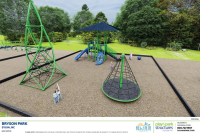Messy lawsuits likely left in landslide’s wake
It could take months or even years for lawsuits over a massive landslide in Maggie Valley to be resolved, leaving affected property owners in limbo over who is financially responsible for the damage to their homes.
The landslide originated from Ghost Town in the Sky, a mountain top amusement park, where a giant system of terraced retaining walls gave way. N.C. Geologist Rick Wooten does not believe the slide was solely due to natural causes, but could not be more specific.
“We are not ready to make any kind of statement on that or jump to any conclusion on that yet,” Wooten said.
The retaining walls have been a source of consternation for Ghost Town over the years, according to those familiar with the amusement park’s history. When the park was built in the 1960s, the top of the mountain was leveled off and dirt pushed over the side. The terraced system attempts to hold that dirt in place.
It has occasionally slumped in places but a major section gave away in 2007. Ghost Town hired an engineer and contractor to make repairs to portions of the terraced slopes.
But some of the old walls — constructed out of railroad ties — were left in place.
Related Items
Last Friday night, heavy rain exacerbated by melting snow triggered a landslide that started at the retaining wall. The question is whether the old portion of the railroad tie walls or the new walls constructed in 2007 were at fault. The slide took out some of both.
“Obviously there is a responsible party, but I am going to let the engineers and attorneys figure that out,” Ghost Town CEO Steve Shiver said. “We are not going to make any comment about liability.”
Pat Burgin, a local engineer hired by Ghost Town, said the work performed in 2007 was not properly engineered nor constructed by Caroline-A-Contracting of Maggie Valley. The company disputes that, however.
“It is the contractor’s position that there is nothing that they did which resulted in this slide,” said Rusty McLean, a Waynesville attorney providing legal counsel for Caroline-A-Contracting. “They repaired the portion they were hired to repair.”
Ghost Town chose to leave some of the old railroad tie sections in place, “against the recommendation of the company,” McLean said.
Verlin Edwards of Maggie Valley was the engineer for the 2007 work and his son, Colin Edwards, an excavator, performed the work. However, in fall of 2008 they sued Ghost Town for failing to pay the full bill. The suit claimed they were still owed $28,866.
Ghost Town filed for Chapter 11 bankruptcy a few months later, however, and the suit is on hold pending the result of bankruptcy proceedings.
Meanwhile, Ghost Town filed a counter claim arguing the wall was “not property constructed, designed and compacted,” and, therefore, the company shouldn’t have to pay.
One of the old walls built from railroad ties sat at the top of the mountain. If it failed first, it would naturally take out the newer section below it. But if the newer section failed first, it could have yanked the support out from under the older walls above and caused them to collapse. Photographs of the slide clearly show it started at the retaining wall.
Lawsuits are imminent, ones that will likely pit the insurance companies of Ghost Town, the contractor and the homeowners against each other.
Which section of wall failed first — the old portion or new portion — ultimately might not matter in court, however.
“By general statute, the property owner is ultimately responsible,” said Haywood County Planner Kris Boyd.
A third option is that the landslide will be deemed a natural disaster, known in legal terms as an “act of God,” meaning no one is at fault. It also means that damage to homes in the slide’s path won’t be covered, as homeowner’s insurance doesn’t cover natural landslides. No insurance companies offer separate slide policies, either.
“It’s a horrendous problem,” said N.C. Rep. Ray Rapp, D-Mars Hill. Rapp points to an arrangement between the state and insurance companies to provide hurricane coverage for coastal homeowners as a solution for landslides.
“I think if we could do that for property owners on the coast, we should be able to work out a similar package to induce insurers to provide coverage for land movement in the mountains,” Rapp said.
Ghost Town has not made a profit in two years. It hopes to pull through bankruptcy, but has been forced to operate on a lean budget. It has more than $12 million in debt.
“Financially, their hands are tied. It costs a lot of money to move dirt,” said Burgin.
Even after repairing large sections of the retaining wall in 2007, Ghost Town brought in another contractor in 2008 to make more repairs.
“They have been very proactive in trying to deal with it,” Burgin said. “Ghost Town is between a rock and a hard place.”
State codes require a building permit for retaining walls more than four feet high. But it does not appear Ghost Town got a permit when the new portions of wall were built in 2007.
“We could not find any permits directly related to the retaining wall,” said Town Manager Tim Barth, who looked back at building permits from the time period.
Ghost Town CEO Steve Shiver could not say whether they ever got one from the town.
“That would be the responsibility of the contractor,” Shiver said.
However, the state code actually places the onus on property owners to secure necessary permits. Even if Ghost Town had gotten a building permit for the retaining walls in 2007, the permit merely requires the work to be conducted per an engineer’s plan, which was done anyway.
More to come?
The majority of the retaining wall system is still in place.
But the slide undermined the integrity of the remaining sections, making it all vulnerable to another slide, Wooten said.
“There is a lot of unstable material at the top,” Wooten said. “If it should fail in a catastrophic way — which we don’t expect but we have to prepare for it as a contingency — where would it go? For the most part we hope it would follow the path that is there now.”
Meanwhile, residents in the area are advised not to return to their homes. Wooten said it is fortunate there weren’t more homes in the direct path of the slide or the situation could have been far more catastrophic.
Everyone who’s seen the slide — emergency responders, geologists, evacuated residents and even casual observers looking up at the dark swath on the mountain from the valley below — share disbelief that people weren’t killed or injured by the massive wall of fast-moving dirt.
“It is a thousand wonders,” said Marc Pruett, Haywood County Erosion Officer.
Following a major landslide in Macon County in 2004 that killed five people, the state embarked on a major project to map areas vulnerable to landslides. Known as landslide hazard mapping, the state is funding the effort at the pace of two counties per year. If funding remains steady at past levels, Haywood is in the queue for mapping in 2011 or 2012.
It is unclear how helpful the mapping could be to residents in landslide prone areas, however. Wooten, the state geologist, said the mapping is designed to pinpoint areas where the naturally occurring slopes and soil types are landslide prone. But it would not account for sites where excavation and earth-moving have created an artificial risk, Wooten said.
Nonetheless, those who know they live in a vulnerable area could chose to spend the night elsewhere when major rains are forecast.









